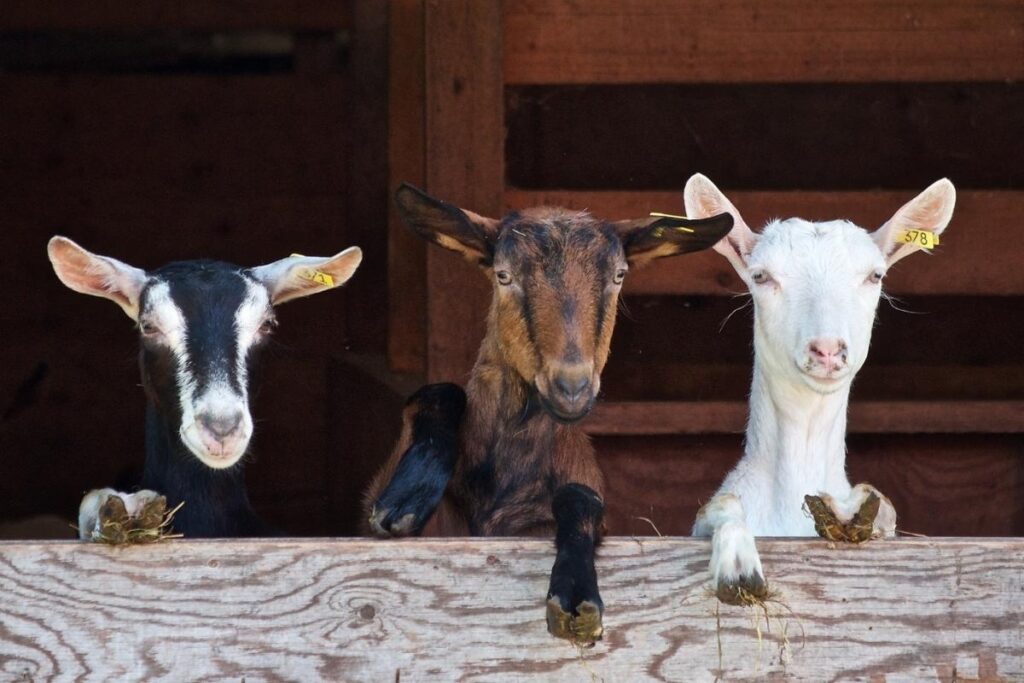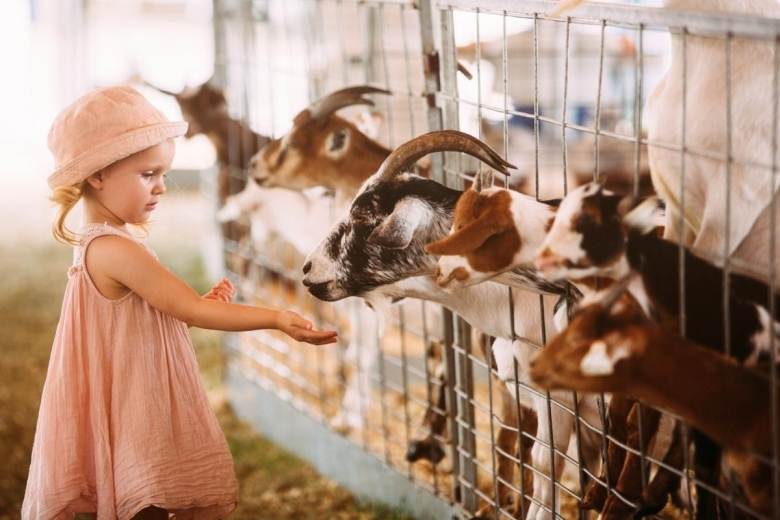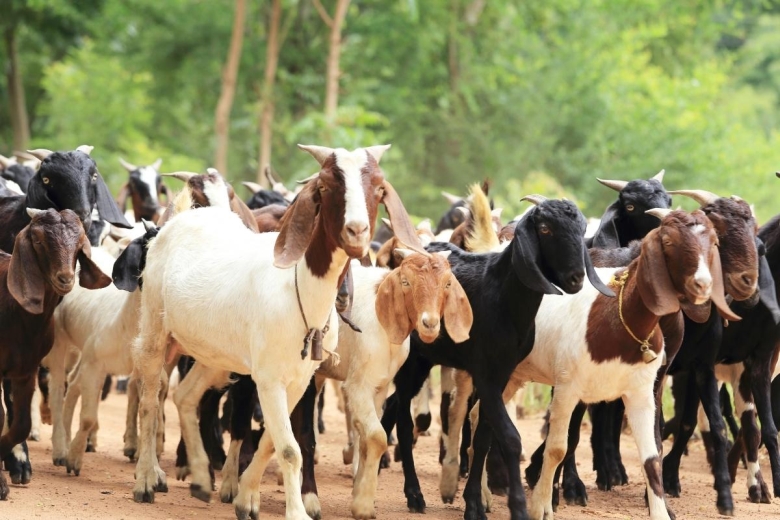
You may have never asked yourself, “How long do goats live?” In fact, you may not make a practice of thinking about goats at all. But, since the humble species has enjoyed an uptick in popularity recently (more on that in a minute), and since gardeners and homesteaders like the ones in this site’s audience are more likely than some others to entertain goat-ish notions, let us regale you with a wealth of info on Capra aegagrus hircus—the domestic goat.
We’ll answer the question, “How long do goats live?” and touch on such subjects as what they require in order to be kept as pets, how they’ve maintained a spot in the public imagination outside the barnyard, the difference between certain species, and more. By the end, you may be closer to wanting to own one or more of these browsing ruminants. If not, at least you’ll have increased your expertise.
Longevity
So, how long do goats live?
The short answer, from general consensus, is from ten to fifteen years, with does outliving bucks in most cases. Of course, a domestic goat that is raised under favorable circumstances—quality food and water, space to roam, frequent interaction with friendly people and other animals, and general good health and temperament—may push the age envelope into extra years, whereas one that faces undue hardship won’t last that long.
It is also important to note that different breeds of domestic goat live longer than others. The Boer breed, for example, is especially resistant to disease, giving Boer does an expected lifespan of up to twenty years! On the other end of the spectrum, the LaMancha breed, traditionally raised for dairy, only lives an average of eight to ten years.
The obvious intimation in terms of goats as pets is that if you’re one to develop an attachment to your animals and not just see them as livestock, you’ll more than likely outlive your goat(s).
An aside: We’ve known one-time dog owners who, after losing their first canine companion to old age, have sworn never to have another dog—they know they can’t go through that kind of grief again, no matter what. Is it possible that the loss of a goat could inspire that kind of sadness and resolve?
We would suggest that goats, though undeniably creatures of unique personality, don’t demonstrate the same kind of love and loyalty dogs do, and so wouldn’t leave as big of an empty space in one’s heart and household. However, we do acknowledge that some goat farmers consider their animals full members of the family—bringing all the associated emotional attachment.
What’s the bottom line? It will differ from homestead to homestead. Just be aware that your goat is no Galapagos tortoise—it won’t be around forever. As with most domestic animals, it’s more a matter of the quality of life than the length of it that’s important for your happy farm.
Living Space
Speaking of living conditions, we know that a domestic goat requires a shelter, apart from its outdoor run, of at least twenty square feet, roofed (and likely walled) against inclement weather. That’s per individual animal. For pasture area outside the enclosure, the general rule is two hundred square feet per Capra.
In case you’re struggling with the mental math, the square footage translates to a 5’x4’ pen and a 25’x80’ grassy run. Your specific dimensions may vary. In any case, don’t forget you’ll need space to store and put out hay and grains, as well as a suitable sheltered area for kidding—that’s giving birth to baby goats (“kids,”) not standing around telling jokes.
Fencing should be solid and sturdy. Goats are notorious chewers and could possibly gnaw their way to freedom through fences or gates bound by rope, twine, and the like. The bad news is, you’ll have to shovel up goat dung from time to time. The good news is that you won’t have to walk your goat like a dog, with the infamous plastic bag in hand.

Nutrition
We’ve answered the question, “How long do goats live?” Now we must ask, “What do goats eat?”
We mentioned hay and grains, above, as supplements to a goat’s fresh grass. But what specifically do they prefer to feed on, and how much of it?
It’s important to remember that goats are ruminant animals—like a cow, they have multiple sections of stomach, each for a particular purpose. The first of these, logically enough, is called the rumen. This organ is the reason that grass hay is acceptable food for part of a goat’s diet—the hay’s long fibers serve as roughage that allows the rumen to help prepare the rest of the stomach for proper digestion. Alfalfa and clover hay are also good. Goats need about three pounds of hay a day, in addition to what they find growing on your property.
The second thing to note about goats’ eating habits is that they are browsers, not grazers like cows and horses. That is, despite the myth about goats being great lawnmowers, they prefer to tear foliage off plants at leg to head height—bushes, small trees, etc. They will certainly munch on tall grass, but set them loose on an overgrown yard and the result will be clumpy and uneven, not uniformly short.
So what else, besides hay in a manger and whatever leaves and twigs are within neck’s reach?
You may have heard that a goat will make short work of your kitchen scraps, and that’s true—just don’t make major changes to your animal’s diet in a short span of time, or you’ll be dealing with messy bouts of goat indigestion. Also, we don’t recommend giving them eggshells, unless you’re willing to clean and disinfect them first, to eliminate the bacteria the shells carry which can be harmful to your goat’s digestion. Fish scraps are better left out, for the same reason. However, if washing out eggshells isn’t too labor-intensive for you, they do make a good source of supplemental calcium.
To round out your goat’s nutritional needs and ensure a healthy animal, follow the lead of experienced farmers and be sure to include what’s called “chaffhaye”—it’s a fermented material rich in healthy bacteria that’s made of grass or alfalfa pieces, molasses, and a probiotic culture called bacillus subtilis. Chaffhaye provides the benefits of regular hay in a smaller package.
Finally, when your goat or goats need additional minerals (like salt), leave the minerals out so your animals can choose when to eat them. Their bodies will tell them when enough is enough.
Solitude vs Group Living
The beginning goat-gardener may ask, “If I buy one goat, shouldn’t I buy two? A single goat would get lonely, wouldn’t it?”
To answer this question, we combed a few reputable sites as well as talking to a couple of goat-owning homesteaders we know. The aggregate wisdom is this: goats, well suited to domestication by humans for thousands of years, are indeed herd-minded animals. A solitary goat will indeed become discomfited if forced to live without others of its kind. Unhappy and prone to misbehavior and ill health. So if your instinct told you that you’d need a pair of goats at the very least, you are correct.
In addition, goats are intellgent and social enough to become jealous when one is given more attention than the other(s). Like other pets, they enjoy affection in the form of petting, soft talking, and feeding by hand–in equal amounts between animals. Favoritism on the goat owner’s part will be noticed.
Finally, to state the obvious, if you don’t want or aren’t prepared for a pregnant doe, make sure the pair you obtain is same-sex. A couple of buck buddies or doe girlfriends not only won’t procreate, but also, unlike some human partners of like gender, won’t go out and adopt a baby goat and bring it home for you to feed.

Pop Culture Goat Q&A
- Why are male goats called “billy goats”?–“Billy” is simply the term for an adult male uncastrated goat, as “ram” is for adult male sheep. It’s unclear how long the term “billy” has been in use, but one of its first appearances in writing was in the children’s rhyme “The Three Billy Goats Gruff,” from the mid-1800s. The word “buck” for adult male goat came into use much more recently, ostensibly because of the negative connotation carried by “billy,” as in, “He stank like a billy goat.”
- Why is the devil portrayed with the head of a goat?–There are several reasons for this, stemming from the portrayal of goats in the Bible. The primary reason for the attachment of evil to goats comes from the ancient tradition of Yom Kippur. During this ritual, the Jewish faithful would choose one goat from their herd and symbolically place all the sins committed by the people over the previous year “on” that one goat–the azazel goat, or “scapegoat.” They would then drive the azazel goat into the desert, banishing all the evil and sin of that year along with it. In this way, among others (including the appearance of the goat-head statue outside the main Satanist church), goats came to be associated with evil in general, and by extension to Satan himself, the Evil One.
- What’s up with goats’ pupils?–The wide, almost rectangular pupils in goats’ eyes are a function of their food-chain status as prey animals. The oddly-shaped pupils give goats a wider range of direct and peripheral vision. As a result, goats and goat relatives in the wild are able to see approaching predators more easily, even when their faces are somewhat buried in the brush, grass, and bushes they browse upon for food.
- What is “goat yoga”?–The goat-yoga craze among fitness enthusiasts and hipsters may seem to defy description, but a diligent web search reveals that yoga’s general physical benefits are enhanced by the presence of the animals simply because their antics cause the assembled yogis to laugh a lot–thereby releasing endorphins and serotonin, brain chemicals known for their positive health effects. However, not everyone sees the use of goats for this purpose acceptable–one country artist known for an affinity for goats has filed a lawsuit against Khloe Kardashian, Kevin Hart, and others to recoup emotional damages. This is due to a negative reaction to the practice of “disbudding,” where super-hot irons are applied to baby goats’ heads to keep their horns from growing and causing trouble in the yoga studio.
- Are goat milk and goat cheese any good?–It depends on whom you ask. In general, goat-derived dairy products are saltier and headier than their cow-derived counterparts. Also, unlike the harder cows’ milk cheeses, goat cheese is soft enough to be spreadable. Some foodies swear by the creaminess of goat cheese as complemented by a baguette slice underneath. Others say that the “fromage du chevre” is too musky to be dealt with at all. Even more otherwise adventurous gourmets find goat’s milk to be an acquired taste. To each his own?
Conclusion
We hope you’ve found that goats as pets or livestock present a lot more to think about than the question of how long they live. We wish you the best of luck in your decision whether or not to acquire a couple of the lovable animals, and we encourage you to share your “goat tales” in the comment section below. As always, if you reside in the area between garden and wildlife, keep checking back here for more info and insights.
